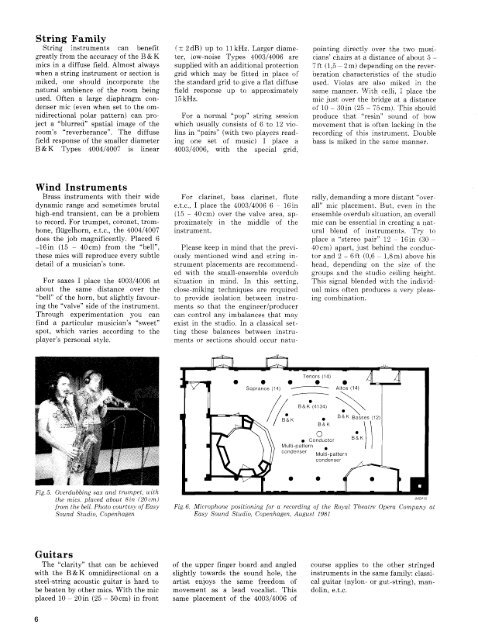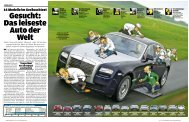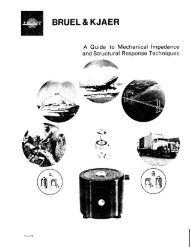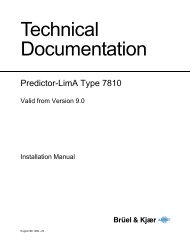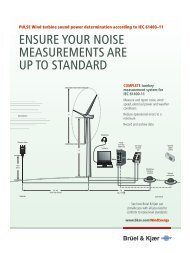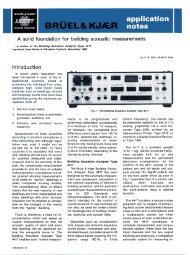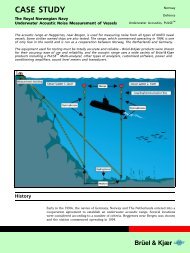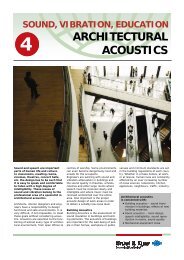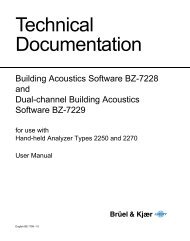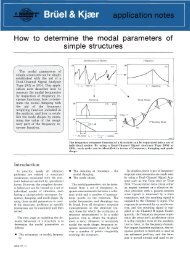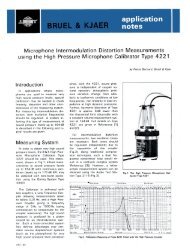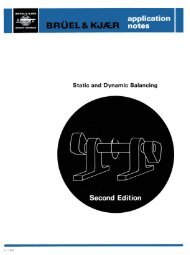The Use of B&K Omnidirectional Microphones for Modern Recording
The Use of B&K Omnidirectional Microphones for Modern Recording
The Use of B&K Omnidirectional Microphones for Modern Recording
Create successful ePaper yourself
Turn your PDF publications into a flip-book with our unique Google optimized e-Paper software.
String Family<br />
String instruments can benefit (±2dB) up to 11 kHz. Larger diame- pointing directly over the two musi-<br />
greatly from the accuracy <strong>of</strong> the B & K ter, low-noise Types 4003/4006 are dans' chairs at a distance <strong>of</strong> about 5 -<br />
mics in a diffuse field. Almost always supplied with an additional protection 7 ft (1,5 - 2 m) depending on the rever-<br />
when a string instrument or section is grid which may be fitted in place <strong>of</strong> Deration characteristics <strong>of</strong> the studio<br />
miked, one should incorporate the the standard grid to give a Hat diffuse used. Violas are also miked in the<br />
natural ambience <strong>of</strong> the room being field response up to approximately same manner. With celli, I place the<br />
used. Often a large diaphragm con- 15 kHz. mic just over the bridge at a distance<br />
denser mic (even when set to the om- <strong>of</strong> 10 - 30in (25 - 75cm). This should<br />
nidirectional polar pattern) can pro- For a normal "pop" string session produce that "resin" sound <strong>of</strong> bow<br />
ject a "blurred" spatial image <strong>of</strong> the which usually consists <strong>of</strong> 6 to 12 vio- movement that is <strong>of</strong>ten lacking in the<br />
room's "reverberance". <strong>The</strong> diffuse lins in "pairs" (with two players read- recording <strong>of</strong> this instrument. Double<br />
field response <strong>of</strong> the smaller diameter ing one set <strong>of</strong> music) I place a bass is miked in the same manner.<br />
B&K Types 4004/4007 is linear 4003/4006, with the special grid,<br />
Wind Instruments<br />
Brass instruments with their wide For clarinet, bass clarinet, flute rally, demanding a more distant "over-<br />
dynamic range and sometimes brutal e.t.c, I place the 4003/4006 6 - 16 in all" mic placement. But, even in the<br />
high-end transient, can be a problem (15 - 40cm) over the valve area, ap- ensemble overdub situation, an overall<br />
to record. For trumpet, coronet, trom- proximately in the middle <strong>of</strong> the mic can be essential in creating a nat-<br />
bone, ilugelhorn, e.t.c, the 4004/4007 instrument. ural blend <strong>of</strong> instruments. Try to<br />
does the job magnificently. Placed 6 place a "stereo pair" 12 - 16 in (30 -<br />
-16in (15 - 40 cm) from the "bell", Please keep in mind that the previ- 40 cm) apart, just behind the conduc-<br />
these mics will reproduce every subtle ously mentioned wind and string in- tor and 2 - 6ft (0,6 - 1,8m) above his<br />
detail <strong>of</strong> a musician's tone. strument placements are recommend- head, depending on the size <strong>of</strong> the<br />
ed with the small-ensemble overdub groups and the studio ceiling height.<br />
For saxes I place the 4003/4006 at situation in mind. In this setting, This signal blended with the individ-<br />
about the same distance over the close-miking techniques are required ual mics <strong>of</strong>ten produces a very pleas-<br />
"bell" <strong>of</strong> the horn, but slightly favour- to provide isolation between instru- ing combination.<br />
ing the "valve" side <strong>of</strong> the instrument. ments so that the engineer/producer<br />
Through experimentation you can can control any imbalances that may<br />
find a particular musician's "sweet" exist in the studio. In a classical set-<br />
spot, which varies according to the ting these balances between instru-<br />
player's personal style. ments or sections should occur natu-<br />
Fig. 5. Ouerdubbing sax and trumpet, with<br />
the mics. placed about 8in (20cm)<br />
840415<br />
from the bell. Photo courtesy <strong>of</strong> Easy Fig. 6. Microphone positioning <strong>for</strong> a recording <strong>of</strong> the Royal <strong>The</strong>atre Opera Company at<br />
Sound Studio, Copenhagen Easy Sound Studio, Copenhagen, August 1981<br />
Guitars<br />
<strong>The</strong> "clarity" that can be achieved <strong>of</strong> the upper finger board and angled course applies to the other stringed<br />
with the B&K omnidirectional on a slightly towards the sound hole, the instruments in the same family: classi-<br />
steel-string acoustic guitar is hard to artist enjoys the same freedom <strong>of</strong> cal guitar (nylon- or gut-string), man-<br />
be beaten by other mics. With the mic movement as a lead vocalist. This dolin, e.t.c.<br />
placed 10 - 20 in (25 - 50 cm) in front same placement <strong>of</strong> the 4003/4006 <strong>of</strong><br />
6


